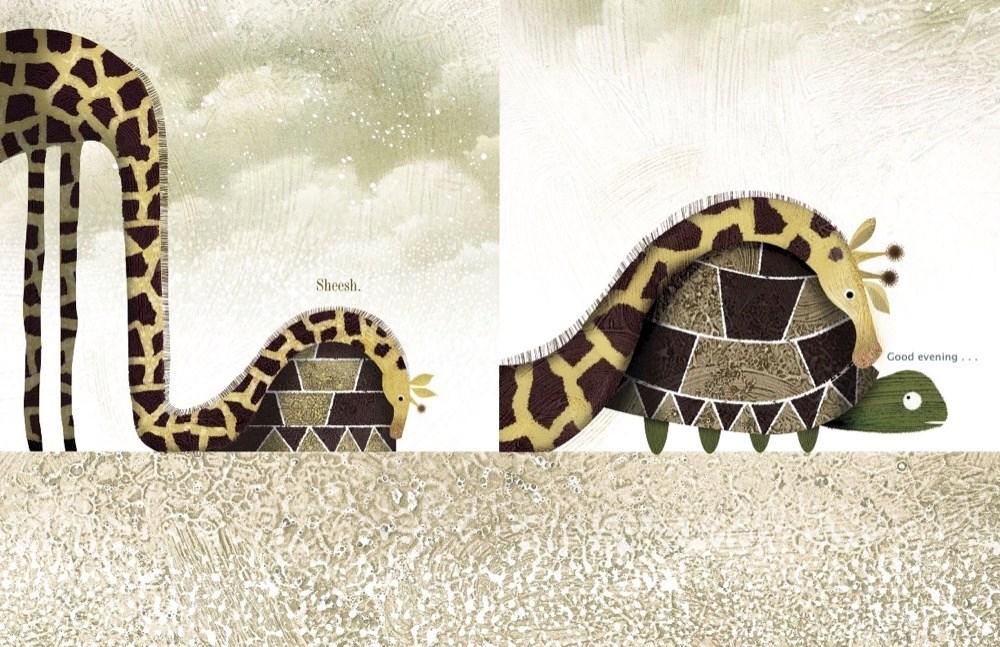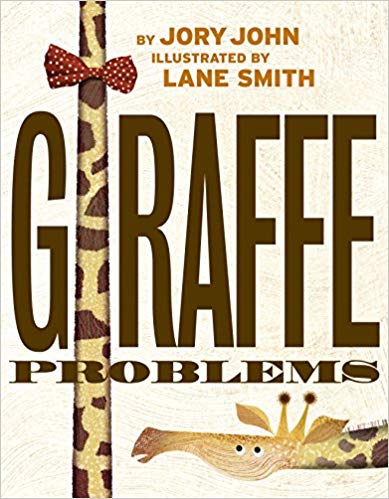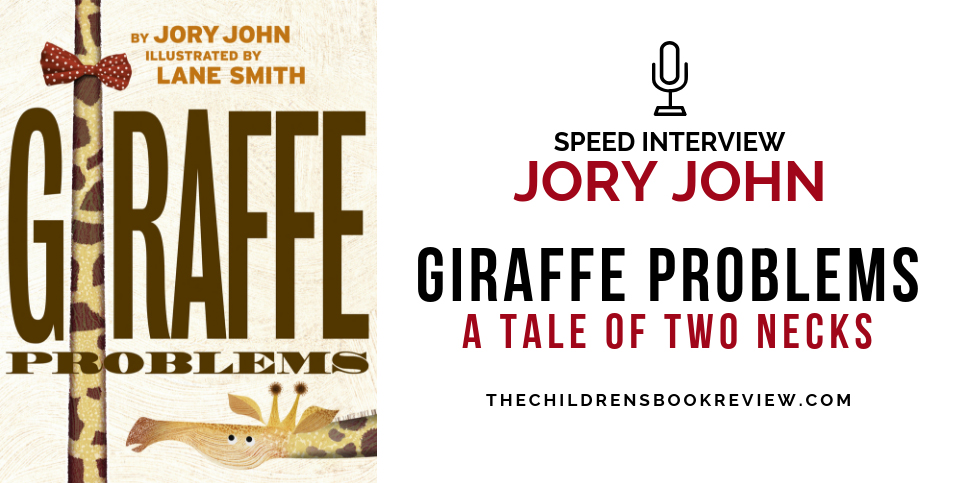The Children’s Book Review | December 21, 2018
The Children’s Book Review: Which five words best describe Giraffe Problems?
Jory John: A tale of two necks.
Can you share a highlight from the book? Or maybe your thoughts on, or an excerpt of, your favorite sentence, paragraph, or page?
There’s a moment where the giraffe’s rant is interrupted by an unexpected source, somebody the giraffe initially mistakes for a large rock. I really like this second voice arriving and taking over in a big way. This leads to an epic monologue about—among other things—a banana. Intrigued?

If you had to take a vacation with one of the characters from Giraffe Problems, who would it be? Why?
Probably the giraffe, since I know him the best at this point. He was created first. Also, if we went somewhere tropical, just think about all the cool stuff he could grab out of trees for me! Coconuts, fruit, leaves, bark, squirrels, you name it. So convenient.
What has been the best reaction from a reader, so far?
My editor, Maria, seems to really love it. Does that count? Actually, I’m starting to hear from a variety of people, as the book heads out into the world, and it’s been really positive and flattering, with lots of nice reviews and blog posts and such. Recently, a bookseller wrote a very thoughtful article for “Publishers Weekly” about engaging, funny read-alouds for classrooms and included “Giraffe Problems” at the very top. One of my favorite quotes comes from the Instagram book reviewer, Picture Books Blogger, who called it, “Side-splittingly funny, totally original and one to return to time after time.” So that was incredibly nice. It’s so fun and heartening hearing from people about the book because it takes quite a while from writing-to-publication. About two years, actually. So I’ve been (impatiently) waiting for it to come out since about 2016. Finally, people are seeing it and reading it!
What’s on your nightstand? Any books?
Oh goodness, tons of books, if by “nightstand” you mean “floor,” because I don’t own a nightstand, and also think “nightstand” is kind of a weird word. But yeah, I have a variety of books on my floor, all the time. Right now, I’m rereading a treasury of the brilliant series “George and Martha” by James Marshall, along with “A Light in the Attic” by Shel Silverstein, “The Lifters” by Dave Eggers, “Superfudge” by Judy Blume (I read it when I was a kid, but I’m revisiting certain books that I loved), “Sick in the Head,” a book of comedic interviews by Judd Apatow . . . and I also read picture books all the time, including the recent additions, “Leave Me Alone!” by Vera Brosgol “T-Rex Time Machine” by Jared Chapman, and “Alexander and the Terrible, Horrible, No Good, very Bad Day” by Judith Viorst.
For your writing energy: sugar or salt, tea or coffee?
Definitely coffee, first and foremost. I bought a machine that turns little pods of coffee grounds into actual cups of coffee. Science is truly amazing, huh? So now I never have to leave the house, although I’m not completely sure if that’s a good thing. As for tea, I don’t drink a ton of it, unless I’m getting a sore throat, or I want something right before bed. But it doesn’t do much for me in the way of a boost. And I actually prefer salt over sugar, if you can believe that. My favorite salty things? I’m glad I asked. They include: pickles, green olives, and mustard. I’ve even had mustard on my salad! (Please note: I’m not talking about a mustard-infused dressing. I’m talking about plain ol’ yellow mustard. Yep.)
Writing tools: computer, pen and paper, or all of the above?
Usually, I start with a pen and index cards, while I’m brainstorming ideas. Then, when I expand an idea into a draft, I’ll write longhand in a composition notebook. Finally, when I’m polishing things up, I’ll type what I have and look for places to add, subtract, or rewrite completely. I think having to retype the whole draft also helps me see what’s working, or what isn’t working, with fresh eyes. I think it helps with the rhythm, too. Later, I print it out and edit with a pen again. Full circle!
Can you tell us one more thing we may not know about Giraffe Problems, your writing style, or yourself?
I think it’s really important to walk a lot and I take at least two long walks every single day, usually one in the morning and one in the evening. I think walking is a great way to clear your head, get your thoughts in order, and also come up with new ideas. In fact, as soon as I finish this very sentence, I’m going to go for a walk in my neighborhood . . . and now that I’ve said that, I certainly can’t start any new sentences, so I guess this is just going to be a long one, an epic ramble . . . but yeah, I wanted to say thank you for the interview and your thoughtful questions . . . and I hope you like the book . . . and have a great day . . . and I’m going outside now . . . and you should, too.
—
 Giraffe Problems
Giraffe Problems
Written by Jory John
Illustrated by Lane Smith
Publisher’s Synopsis: Penguins aren’t the only animals with problems. . . . A second hilarious collaboration from picture-book superstars Lane Smith and Jory John!
Can you guess what’s making this giraffe self-conscious? Could it be . . . HIS ENORMOUS NECK?? Yes, it’s exactly that–how on earth did you figure it out?
Edward the giraffe can’t understand why his neck is as long and bendy and, well, ridiculous as it is. No other animal has a neck this absurd. He’s tried disguising it, dressing it up, strategically hiding it behind bushes–honestly, anything you can think of, he’s tried.
Just when he has exhausted his neck-hiding options and is about to throw in the towel, a turtle swoops in (well, ambles in, very slowly) and helps him understand that his neck has a purpose, and looks excellent in a bow tie.
Jory John and Lane Smith have truly outdone themselves in this companion book to Penguin Problems.
Ages 3-7 | Publisher: Random House Books for Young Readers | September 25, 2018 | ISBN-13: 978-1524772031
Available Here:
About the Author
JORY JOHN is a New York Times bestselling author and two-time E.B. White Read-Aloud Honor recipient. Jory’s previous collaboration with Lane Smith was the national bestselling picture book, Penguin Problems, an Amazon Best Children’s Book of the Year selection. Jory’s work also includes the award-winning Goodnight Already! series, the bestselling Terrible Two series, the national bestseller All my friends are dead, and the recent picture books I Will Chomp You!, Quit Calling Me a Monster! and The Bad Seed, among many other books for both children and adults. He lives and works in Oregon. Find out more at joryjohn.com.
About the Illustrator
LANE SMITH (also the illustrator of Penguin Problems) has written and illustrated a bunch of stuff, including Grandpa Green, which was a 2012 Caldecott Honor Book; It’s a Book, which has been translated into over twenty-five languages; and The True Story of the Three Little Pigs! Four of his books have been New York Times Best Illustrated Children’s Books of the Year. In 2012 the Eric Carle Museum named him an Honor Artist for “lifelong innovation in the field of children’s books.” In 2014 he received the Society of Illustrators Lifetime Achievement Award. Lane and book designer Molly Leach live in rural Connecticut. Visit him on the Web at lanesmithbooks.com.
This speed interview with Jory John, author of Giraffe Problems, was conducted by Bianca Schulze. For similar books and articles, follow along with our content tagged with Animals, Giraffe Books, Humorous Books, Jory John, Lane Smith, Picture Book, and Speed Interview.

